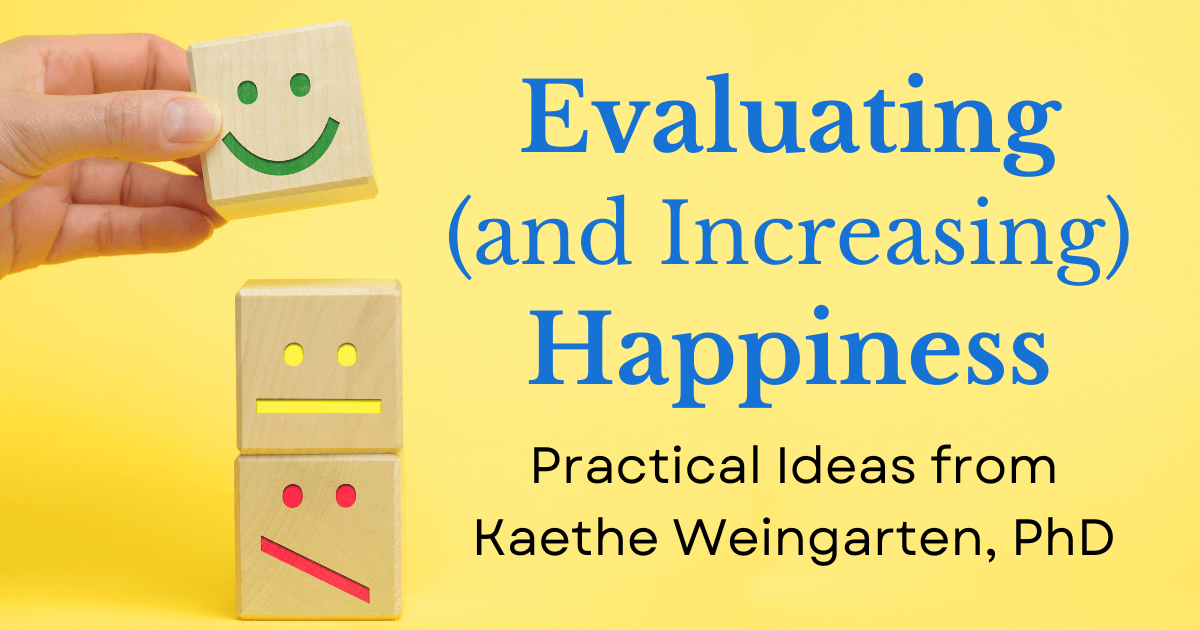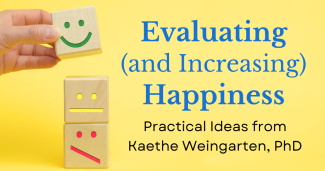Evaluating (and Increasing) Happiness: Practical Ideas from Kaethe Weingarten, PhD

[Editor’s Note: Here on our blog, MCN’s Director of Witness to Witness, Kaethe Weingarten, PhD, shares stories, resources, and helpful tips to support health care workers and others through the many stressors of their daily lives. In this article, Dr. Weingarten outlines the ways that we evaluate happiness on a population scale, and some practical tips to increase it on an individual level. Dr. Weingarten also offers a newsletter (called the W2W Update), filled with resources, recent articles, and her news and views.]
The annual World Happiness Report is based on responses to a single-question survey that asks respondents in 130 countries to think of a ladder, where the highest rung on the ladder, 10, indicates they are currently leading the best possible life they could, and zero, the lowest rung, indicates they are living the worst possible life. The report “reflects a worldwide demand for more attention to happiness and well-being as criteria for government policy. It reviews the state of happiness in the world today and shows how the science of happiness explains personal and national variations in happiness,” according to the Report’s website.
Whenever the report comes out, I read it immediately, although there is something foolish about my eagerness since the “scores” reflect happiness at the population level, not what any one individual – like me – might have been feeling in the year being measured. I thought that Bhutan was the happiest country in the world but according to this Report, Finland has ranked #1 the most times and other Nordic countries have been in the top 10 as well since the beginning. Of note, the US dropped from 15th place to 23rd in the current Report.
Measures of health care worker happiness have also seen a drop since the pandemic. In one survey, 39% of health care workers plan to leave their jobs by 2025. Whereas doing meaningful work is often cited as a source of happiness, when meaningfulness does not balance out risk, moral injury, low compensation, and work overload, happiness plummets.
The Report surveys people from all walks of life, not just health care workers. Every year, about 100,000 people are surveyed. But then what? Do presidents or prime ministers meet with their cabinets or ministers and ask, “What can we do to improve the happiness of our citizens?” California is doing just that. A new committee chaired by Assemblyman Anthony Rendon is the first in the nation to gather data to understand what makes people happy and then to let the information gathered impact policy and legislation. Rendon said in an interview: “Ultimately, I really feel like the only thing we should be concerned about in government in the largest sense is making sure people are living fulfilling and happy lives.”
Hopefully, this committee will look at many sources of data. The Public Policy Institute of California found that more state residents in the last year reported being less happy, and that fewer described themselves as “very happy.” The Los Angeles Times did its own survey and found that the majority of people who answered the questions rated themselves as “fairly” or “very happy” at the moment. They found that responses showed agreement that the factors that make for a happy life are:
- “A strong network of family and/or friends close by.
- Access to public space, especially nature.
- Good health and access to care.
- Stable housing in friendly neighborhoods where they feel safe.”
It will be interesting to see whether Rendon’s committee investigates whether government programs that aim at these factors can increase state residents’ happiness.
In the meantime, what can individuals do to increase their felt sense of happiness? People often turn to religion for the answer. Buddhism’s Four Noble Truths assert that there is an eightfold path one can follow that will lead to the “cessation” of suffering. One of the steps on the eightfold path is “right effort.” Here is one translation of an aspect of “right effort:” “Whatever a person frequently thinks about and ponders, that will become the inclination of their mind.” This statement comes from an online course I am taking that gives me a short verse from a Buddhist text and then provides a reflection on it and a suggestion for a practice I can do whose purpose is to enlarge my understanding of the verse. Today’s reflection on the verse is:
“Sometimes healthy states of mind come up on their own, apparently spontaneously. Other times we have to make them happen. The word for ‘develop’ in Pali (bhāvana) literally means ‘cause to be’ or ‘make become’ and so is very descriptive of the process. The more you experience healthy states, the more they develop, and the more the mind inclines toward what is helpful and skillful.”
At the same time as I am taking this online course, I am reading a book on how emotions are made. There is, or I am making, an astounding congruence between the Buddhist wisdom of thousands of years ago and an innovative theory of emotions put forward in the last few years by Lisa Feldman Barrett, PhD. In an article connected to one of her TED talks, she identifies practices that can help us “train” our emotions so that we “incline”, as the Buddhist precept suggests, more towards what we would prefer to feel. One of the practices involves using more words for what we sense, that is, for what we are feeling. The more nuanced the description of our feelings, the more nuanced our responses and actions can be, which can have consequences: “People who exhibit higher emotional granularity go to the doctor less frequently, use medication less frequently, and spend fewer days hospitalized for illness,” she notes.
She strongly suggests using as many different words as possible to differentiate –with fine granularity – what we are feeling. “Sad” can be broken down into dozens of experiences, as can “happy” or “angry.” There are tools, like emotion wheels, that provide lots of words for the core emotion words like sad, happy, and angry. She even suggests using words in other languages – like the Danish word, “hygge” for cozy, or the Swedish word “mys” for “the feeling of warmth, like being wrapped in a woolen blanket amid lighted candles while sipping a steaming mug of tea with a purring cat on your lap.” I recently read about a book that invents words for experiences that we seem to have no language for.
I am using the idea of emotional granularity in my daily life, and I believe that it is consistent with the teachings on right effort. My dear friend and colleague Victoria Dickerson died this month after a short illness. I have been very sad knowing she would likely die and then sad
because she has died. Thinking more precisely about my sadness, I realize that my sadness is actually a way of noting how much I have loved, and continue to love, my friend, and loving her fits with my values. Naming this sadness as love lightens it for me. It also helps me see that sadness may be many experiences. In this case, it is really a transform of love and love is not heavy to carry.
A second practice that individuals can do is to practice doing one thing at a time. We all probably know by now that we cannot really multi-task. For most of us, the more tasks we try to do at the same time, the less efficient we are and the poorer our performance is with each. When we do many things at once, we are also training our minds to be less, not more, aware. Andrew Olendzki, PhD, a professor at Lesley University and the director of its graduate program in Mindfulness Studies, wrote: “The Buddha might have said: ‘I know of no single thing healthier than doing one thing at a time.’”
Many people have tried meditation or mindfulness practices to achieve a mind more adept at doing one thing at a time. To reach this goal, I have discovered ping pong. I find I am only able to return the ball if my mind never wanders and I bring my full attention to the game. I try to play daily. My three-year-old neighbor, I am told, asks his parents why I am laughing when I play ping pong. The relaxation I feel, the pleasure I feel, at returning the ball, the humor I find when the ball goes haywire, all release any tension or distress I may have carried with me to the table.
I am sure that policies can have an impact on personal happiness. The Nordic countries do have an array of government policies whose purpose is to support their citizens. But each of us can also have a bit more control over our happiness by inclining ourselves to those activities we associate with our happiness. Like others in my state of California, the four factors identified in the LA Times survey are ones I can endorse. But so is fine-tuning the names I give to my feelings and yes, hitting that orange ping pong ball over (or into) the net.
Access numerous Witness to Witness resources in English and Spanish:
https://www.migrantclinician.org/witness-to-witness
- Log in to post comments






